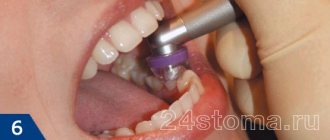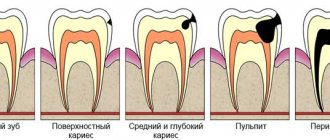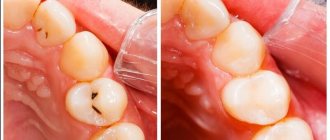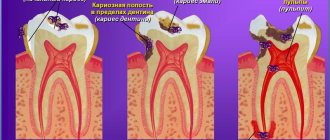One of the most common reasons for visiting a dentist is the treatment of dental caries. What methods are used in modern dental practice, whether it is possible to cure an affected tooth without preparation, we will talk about this in the article.
The development of dental caries is based on the consumption of large amounts of carbohydrate foods, insufficient oral hygiene, and the accumulation of food debris on the teeth and in the interdental spaces. All this serves as a favorable environment for the proliferation of cariogenic microbes.
In this article
- What methods do dentists use to combat caries?
- Technology for treating enamel caries in the spot stage
- Modern technology for treating caries without preparation
- Technology for caries treatment using ozone therapy
- New technologies for caries treatment using laser
- When are invasive caries treatment methods used?
- Basic principles of cavity preparation
- How are carious cavities prepared?
- Mechanical and chemical-mechanical preparation
- Air-abrasive method of preparation
- Laser preparation
- Surgical treatment of caries
They ferment sugar and produce acid, which destroys tooth enamel, dentin and other tooth tissues. The higher the concentration of bacteria in plaque, the more acid they produce, and the faster caries develops.
What methods do dentists use to combat caries?
All methods of treating dental caries can be divided into two large groups - invasive and non-invasive. The first involves treating enamel caries without preparation. This option is most often used when the carious lesion is in its initial stage, there is no extensive damage to the deep tissues of the tooth, or there are indications for anesthesia.
Invasive technologies are used much more often and involve tooth preparation and removal of tissue affected by caries. The degree of preparation depends on how severely and deeply the tooth is affected.
The optimal treatment regimen and method is always selected by the dentist, taking into account age, individual characteristics, stage of disease development, anesthesia tolerance and other factors.
Pros and cons of caries infiltration using the Icon method
Today, various types of caries treatment without a drill are used in many advanced clinics - both in Russia and around the world. The popularity of Icon proves that infiltration is a reliable and successful technology. In many ways, this is true, but there are experts who have a rather cool attitude towards this technique, pointing out some disadvantages. Some of them do not recommend the use of technology even with the slightest damage to dentin.
- Treatment of initial caries using the Icon system is a reliable and safe method.
- Maximum preservation of tooth tissue and strengthening of enamel structure.
- The patient does not feel pain and experiences discomfort.
- For people who are afraid of drills and injections, the innovative treatment of caries with the Icon system will be an excellent alternative.
- The procedure takes no more than half an hour.
- Suitable only for eliminating initial forms of caries.
- There is no 100% guarantee of protection against secondary caries (although this risk is minimal).
- The technique is not practiced in all clinics.
- If we consider the same clinical cases, then prices for Icon are on average 1,000 - 2,000 rubles higher than for installing a filling.
Technology for treating enamel caries in the spot stage
A symptom of early caries is a small light spot on the surface of the tooth enamel. This area is a focus of demineralization, that is, in this area the enamel began to lose minerals. At this stage, it is possible to restore the normal structure of the enamel by replenishing the lack of mineral components.
The main method of treating caries at this stage is remineralizing therapy. It can be performed either in the dentist's office or at home. Home remineralization involves the following procedures:
- The use of medicated toothpastes and gels with fluoride, calcium and phosphorus.
- As prescribed by the dentist, a course of mousse or gel applications with phosphates and calcium. Usually they are carried out in courses of 10 days, repeating every month.
Professional remineralization of tooth enamel is carried out by a doctor. It may include several types of procedures:
- Simple fluoridation.
Coating teeth with fluoride-containing gels, solutions, varnishes, applying calcium and fluoride-containing preparations. These procedures are performed after comprehensive professional teeth cleaning. At the same time, the carious stain, even after remineralizing therapy, does not always disappear completely. The earlier treatment of dental caries in the stain stage is started, the better the prognosis.
- Deep fluoridation.
This method of caries treatment involves the use of special drugs that seal the tooth enamel. This approach ensures the deposition of fluoride in dental tissues, which is important for long-term exposure to fluoride.
Preventive measures
The risk of developing dental caries cannot be completely eliminated. However, following certain medical recommendations can reduce the likelihood of tissue damage. Among them:
- high-quality and regular teeth cleaning. Not only the surface of the teeth, but also the tongue and cheeks should be cleaned of plaque;
- rinse your mouth after every meal. For these purposes, it is preferable to use special rinses;
- flossing after meals;
- balanced diet;
- giving up bad habits - smoking, drinking alcohol;
- reducing or eliminating the consumption of coffee and sweets;
- Regular visits to the dentist - at least once every 6 months.
By following these rules, you can significantly reduce the risk of rapid development of caries and tooth loss. After completing caries treatment, the patient must carefully monitor the condition of the oral cavity and adhere to all the dentist’s recommendations.
Modern technology for treating caries without preparation
An alternative to remineralizing therapy at the stage of a carious spot or superficial caries can be a modern infiltration method. With this technology, it is possible to avoid the most uncomfortable stages of dental treatment - anesthesia and preparation.
This technique assumes that a drill is not used for dental treatment and an anesthetic injection is not given. The essence of the procedure is that a synthetic gel-polymer penetrates the layer of tooth enamel that is affected by caries. The high fluidity resin included in its composition prevents acids and toxins released by bacteria from penetrating the porous enamel. Thus, the development of caries is blocked at an early stage. The technology helps treat tooth enamel, thicken and strengthen it. Infiltration therapy increases the resistance of enamel to negative environmental influences. In some cases, ICON allows you to return your teeth to their natural, even color and enamel transparency.
The procedure is carried out in several stages:
- First, the affected tooth is treated with a special gel that cleans the surface layer of enamel.
- Then, using a special type of alcohol, the tooth surface is dried.
- At the third stage, the tooth is covered with a special infiltrant - this is a composite that seals the enamel pores.
The procedure is performed very quickly and does not cause discomfort to the patient. However, treatment of caries using the ICON method is recommended only for initial damage to the enamel. The technology is not suitable for the treatment of medium or deep caries, and, unlike fluoridation, it is not used for preventive purposes.
What happens if caries is not treated?
Caries is a source of infection in the body. If it is not eliminated, then both local and general complications are possible:
- Local complications - the infection moves deeper after the destruction of the crown. First, painful pulpitis develops, and then, if you continue to ignore the toothache and suppress it with pills, the infection moves through the root canals to the apex of the root and spreads to the periodontium. Long-term periodontitis means severe pain and the risk of developing such serious, life-threatening complications as abscesses, osteomyelitis (inflammation of bone tissue), and meningitis.
- Common complications are the penetration of infection into the vascular system with spread throughout the body. The development of infectious and inflammatory processes in any organs and tissues is possible. Very often, carious teeth are the source of severe infectious and allergic processes, such as glomerulonephritis, myocarditis, etc.
All these complications can be eliminated only by timely treatment of caries.
Technology for caries treatment using ozone therapy
This is one of the new methods, which is based on the oxidizing effect of ozone. By acting on the tooth, it promotes the death of cariogenic microbes, neutralizes acids produced by bacteria, allowing the mineral components of saliva to restore the mineral balance of tooth enamel.
Ozone therapy is performed in a dental clinic using special equipment. The procedure is painless and lasts about 30 seconds. Ozone penetrates the biological film in a matter of seconds, destroys microbes and cleanses dental tissue. After ozone therapy, remineralization is usually carried out or fissures (natural depressions in the teeth) are sealed.
High system efficiency
Patients prefer our dental clinic “Vivadent”, as it is one of the best clinics in Moscow, using the most modern, high-quality and effective methods for the prevention and treatment of teeth, tested by outstanding American and European specialists.
We employ highly qualified professionals with extensive experience. We constantly improve our knowledge and skills, study new treatment methods developed by world experts in the field of dentistry. It is very important for our clinic that every patient feels comfortable and receives painless treatment of the best quality at an affordable cost. You can find out more about the list of services and costs on our official website or from the clinic administrator.
Never forget that shining healthy teeth are our calling card, so everyone should visit the dentist regularly. This is the surest way to maintain a great smile for many years and avoid painful treatment.
New technologies for caries treatment using laser
Another non-invasive method in which a laser beam non-contactly affects the affected tooth tissue without affecting healthy ones. The method has both pros and cons.
Main advantages:
- there is no need for anesthesia because the treatment is painless;
- You can treat teeth with laser from childhood;
- the laser beam destroys microbes and seals blood vessels, the risk of complications after such treatment is minimal;
- laser equipment does not make frightening and unpleasant sounds like a drill, so even small patients do not experience fear during the procedure;
- the device allows you to control the laser penetration depth and impact power;
- Unlike dental burs, the laser beam does not leave microcracks in the enamel.
The disadvantages of the method include the relatively high cost of treatment and the need to protect the eyes with special glasses. Like other non-invasive methods, laser therapy is effective only in the initial stages of caries.
Certificates
See all
Impeccable reputation
Numerous reviews from grateful VivaDent patients confirm the professionalism of our doctors
When are invasive caries treatment methods used?
Not everyone goes to the dentist at an early stage, when caries is just a light spot on the enamel. This is due to the fact that in the initial stage the disease is not accompanied by pain, discomfort and other noticeable symptoms. Similar signs appear already at the stage of medium or deep caries, when the lesion has affected the dentin and a cavity has formed in the tooth. In such cases, when treating teeth with caries, one cannot do without preparing, cleaning and filling cavities.
The algorithm for invasive treatment of caries consists of several stages:
- First, the tooth is numbed with an anesthetic injection. People who are allergic to anesthesia or have a high sensitivity threshold sometimes have their teeth treated without anesthesia.
- The dentist cleans the surface of the tooth from plaque.
- Using a special plate, it isolates the tooth from saliva, since the cleanliness and dryness of the treated area directly affects the effectiveness of the treatment.
- The dentist then removes the tissue affected by tooth decay. Most often, using a drill, but other methods are also possible.
- After removing all the affected tissue, treating the cavity with acid and adhesive for better adhesion of the filling to the walls, the doctor restores the anatomically correct shape of the tooth using a filling. Light-curing fillings are considered the most modern and reliable. They are applied in layers, with each layer illuminated with a special lamp.
- After installing the filling, it is adjusted to the bite, polished and ground. At this point, the treatment of caries is considered complete.
Recommendations after treatment
After treatment and filling, pain, discomfort and other problems may occur. The following recommendations from your doctor will help you cope with them:
Recommendations for eating:
- after installing the filling, you should not eat for 2 hours: this recommendation is necessary in order to avoid injury to the inner surface of the cheeks and lips due to the ongoing effect of anesthesia; a person may not notice how he bites himself on the cheek;
- For a week, do not drink very cold or hot drinks, as well as hard and sticky foods - nuts, seeds, toffees, toffees, etc.; such products can be consumed if chewed on the side opposite to the treated tooth;
- do not consume coloring products - coffee, tea, red wine, beets; This is especially true when installing fillings made of photopolymer composites.
Pain and discomfort. After the anesthesia wears off, toothache may appear, but it is moderate and gradually subsides. This is the norm. You can rinse your mouth with an infusion of chamomile or sage flowers.
You should consult a doctor if:
- there was an acute growing pain;
- pain is accompanied by swelling of the cheek;
- pain is accompanied by an increase in body temperature;
- discomfort occurs due to the lack of complete closure of the dentition after the anesthesia wears off.
Oral hygiene. Oral care includes brushing your teeth twice a day using a soft-bristled brush. It is better not to use dental floss, as it may help remove the filling. It is better to use irrigators to clean the interdental spaces.
Proper and thorough brushing of teeth is the best prevention of caries
Basic principles of cavity preparation
Preparing the cavity of a diseased tooth is one of the most important stages in the treatment of caries.
Modern methods require a special approach to the preparation of carious cavities. Professional dentists follow five basic principles when performing this procedure:
- Biological feasibility.
All dental tissue affected by caries must be excised.
- Gentle treatment of dental tissues.
The dentist chooses an approach to caries treatment that will maximize the preservation of healthy tissue.
- Compliance with aseptic and antiseptic requirements.
All instruments that come into contact with teeth, oral mucosa, saliva and blood must be sterile. If technologies are used that create aerosols in the air, it is necessary to use eye and respiratory protection.
- Painless manipulations.
Any painful interventions are carried out only with the use of anesthetic drugs. During the preparation process, the dentist observes a number of conditions that make cavity treatment minimally painful: he works only with sharp burs, prepares the cavity with intermittent movements, uses the air-water cooling method, uses high-speed tips, etc.
- Biomechanical compliance.
The shape of the carious cavity must correspond to the physical and mechanical properties of the filling material and dental tissues that surround the cavity.
Materials and anesthesia
In the past, silicate cements and amalgam were often used to treat caries. They were distinguished by high solubility and low hardness, but now these products are not used. In modern dentistry, in the natural treatment of caries, composite materials and light/chemically cured ionomer cements are used, which have excellent aesthetics, fixation, and strength, guaranteeing reliable filling.
Anesthesia during dental procedures can reduce the patient’s fear, eliminate pain, reduce the risk of complications, and make the dentist’s work easier. The choice of anesthetic is determined by the allergic/somatic status of the patient. Different types of anesthesia are used: general, local, combined.
Typically, injection anesthesia is performed with solutions of lidocaine, trimecaine, novocaine with adrenaline - these drugs inhibit pain, reduce bleeding, and constrict blood vessels. According to indications, premedication is carried out to eliminate panic, fear, psycho-emotional agitation, prevent an allergic reaction, and enhance the effect of the anesthetic.
Mechanical and chemical-mechanical preparation
With the mechanical method, the carious cavity is prepared using hand instruments and dental burs. This option is the most common.
During chemical-mechanical preparation, the dentist first acts on the affected dental tissues with special solutions and gels that destroy the areas affected by caries. And then, using hand instruments, he cleans the cavity and fills it.
There is also an ART technique developed in Russia, in which the affected tissue is first removed with a hand instrument, then gels with different effects are applied one by one. The treatment is completed by re-cleaning the cavity using instruments and rinsing with water.
Air-abrasive method of preparation
Essentially, this is sandblasting the hard tissues of a diseased tooth. Through a special tip, an aerosol containing water and an abrasive substance is applied to the surface of the tooth. This method is used before sealing fissures or to remove pigmented areas of tooth enamel.
The air abrasive method can be used to prepare small carious cavities. The advantages of this method are minimal tissue excision and the creation of a rough surface that does not require additional acid etching.
Laser preparation
With this method, the dentist uses pulsed lasers specially designed for dental treatment. The device consists of three basic elements - the main block, which produces radiation of a specific frequency and power, as well as a light guide and a tip. It is with the help of the tip that the dentist performs manipulations in the patient’s oral cavity. The tips come in different shapes, but all have a cooling system.
The process of laser tooth preparation is carried out in this way. The base unit produces laser beams. Getting on the hard tissues of the teeth, they heat the moisture contained in them. Something like an explosion occurs, which leads to microscopic destruction in the tooth enamel and dentin. At the same time, nearby tissues heat up slightly. Then, using a spray of water and air, particles of dental tissue are removed from the oral cavity. What is the advantage of laser preparation compared to mechanical preparation? In the first case, there is no irritation of nerve endings and strong heating of hard tissues, so the laser procedure is painless and does not require anesthesia. Also, laser treatment of the cavity is more controlled and faster, and the surface of the carious cavity after laser treatment does not require additional etching.
After preparation, the dentist treats the carious cavity with medication and installs a filling. In some cases, after filling it is necessary to additionally remineralize the tooth.
Surgical treatment of caries
Surgery may be required in the following cases:
- if drug methods turned out to be ineffective in the treatment of deep caries;
- if caries is complicated by other diseases.
Depending on the complexity, surgical treatment can be performed both in a hospital and on an outpatient basis.
The best way to avoid surgery is to see your dentist promptly and treat tooth decay in its early stages. Remember: the sooner you see a dentist, the faster, simpler, painless and affordable the treatment will be.
Pain and other complications after treatment
Complications are possible, but rare, as a competent dentist will try to avoid them. The doctor will also warn that slight soreness appears after the anesthesia wears off and may last for 2 to 3 days. If the pain does not increase, but, on the contrary, decreases in intensity, then this is normal.
You need to see a doctor urgently if:
- there was severe increasing pain;
- the pain intensified, the cheek became swollen;
- headache appears, fever or low temperature lasts more than two days.









